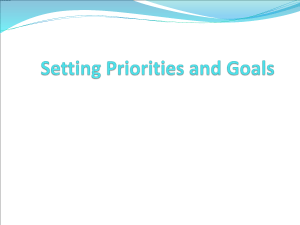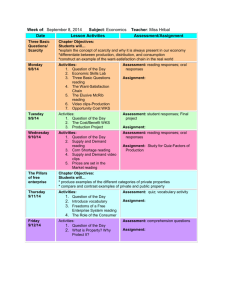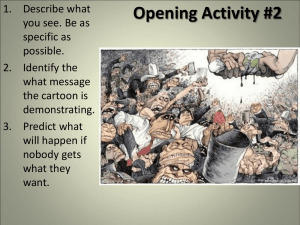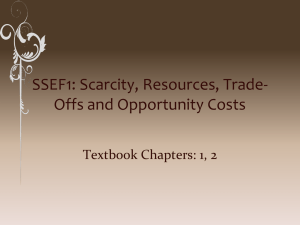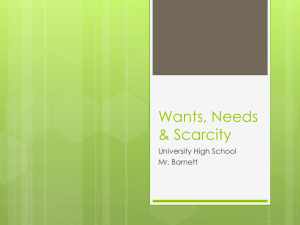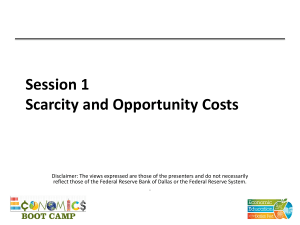Understanding By Design Unit Template
advertisement
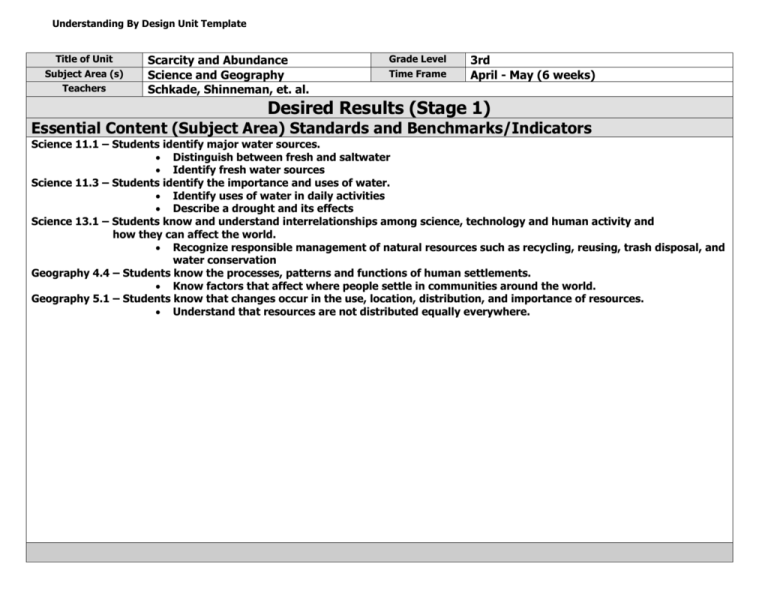
Understanding By Design Unit Template Title of Unit Subject Area (s) Teachers Scarcity and Abundance Science and Geography Schkade, Shinneman, et. al. Grade Level Time Frame 3rd April - May (6 weeks) Desired Results (Stage 1) Essential Content (Subject Area) Standards and Benchmarks/Indicators Science 11.1 – Students identify major water sources. Distinguish between fresh and saltwater Identify fresh water sources Science 11.3 – Students identify the importance and uses of water. Identify uses of water in daily activities Describe a drought and its effects Science 13.1 – Students know and understand interrelationships among science, technology and human activity and how they can affect the world. Recognize responsible management of natural resources such as recycling, reusing, trash disposal, and water conservation Geography 4.4 – Students know the processes, patterns and functions of human settlements. Know factors that affect where people settle in communities around the world. Geography 5.1 – Students know that changes occur in the use, location, distribution, and importance of resources. Understand that resources are not distributed equally everywhere. National Education Technology Standards Creativity and Innovation (Choose 2-3 to focus on) X Communication and Collaboration X Research and Information Fluency X Critical Thinking, Problem-Solving and Decision-Making Understandings Overarching Understanding (“Big Idea”) Students will understand that scarcity and abundance of resources impacts patterns of human settlement and human use of resources. Digital Citizenship Tech Operations and Concepts Essential Questions (connected to overarching and supporting understandings) Why is clean water scarce or abundant in certain places? How do human populations utilize water? How has availability of resources affected where humans choose to live? Supporting Understandings Students will understand… 1. What makes a resource renewable versus non-renewable. 2. How people adapt to scarcity or abundance of a resource. 3. Why water is valuable for various human activities. 4. Why water is scarce or abundant in different places. 5. How a civilization’s use of resources impacts their scarcity or abundance. 6. History of settlement patterns by civilizations. How have people in past and present civilizations adapted to scarcity and abundance of resources? What are examples of how humans have caused water scarcity or abundance? How do human populations control who has access to scarce resources? Knowledge Skills Students will know… Students will be able to… 1. 2. 3. 4. 5. 6. 7. What renewable and non-renewable resources are. What scarcity and abundance mean. What common patterns for human settlement have been. What the difference between fresh and salt water is. How the water cycle works. What a civilization is. What various sources of water on Earth are. 1. Identify how people use water in their daily lives. 2. Research patterns of human settlement based on location of resources. 3. Describe how access to water is controlled in the local community. 4. Provide examples of how people in various communities and civilizations have adapted to scarcity or abundance of water. 5. Make informed choices based on a review of data Assessment Evidence (Stage 2) Assessment of Overarching Understanding/Big Idea Assessment Criteria (students will be able to… student application of Six Facets of Understanding) Students provide examples of how human settlement has been based on the scarcity or abundance or resources Students determine a good location for human settlement based on the availability of resources (application and interpretation)) Students explain how human use of resources has affected their availability (explanation) Assessment Tool (describe type of assessment tool to be used here - post completed tool with unit) Rubric, with student input. Assessment Strategy (performance task description) Your goal is determine a location for a community based on research of the availability of resources in a certain area, and a review of where and why previous civilizations have settled. Goal Students are researchers and community planners. Role Audience The people moving to the new community. The people who are funding the new community. People who already live in the area. The inhabitants of the local ecosystem. Forming a community in a place with sufficient resources to support human settlement. Situation Product/Performance Students will work in teams to research settlement patterns of past civilizations and based on this and a review of the availability of resources today, create a proposal for the location of a new community today. Students will also need to assess the impact of the new communities use of surrounding resources upon their future availability. Groups will present their proposals to a panel of teachers, parents and peers representing the roles of potential members of the new community, funders of the community, scientists and current inhabitants of the area where the proposed community will be located. The members of this panel will assess and provide feedback on groups’ proposals. (NETs communication and collaboration a and d; research and information fluency b; critical thinking, problem solving and decision-making c and d) Standards Students provide examples of how human settlement has been based on the scarcity or abundance or resources Students determine a good location for human settlement based on the availability of resources (application and interpretation) Students explain how human use of resources has affected their availability (explanation) Evidence of development of supporting understandings, knowledge and skills (identify assessment criteria, strategies and tools for each) Students will explain how the water cycle, rainfall patterns and geologic features affect scarcity or abundance of water in different areas. Task: students will work in pairs to use Google Earth and online Weather Maps/rainfall pattern charts to explain the scarcity or abundance in explain why they believe water is scarce or abundant in a specific area of the Earth (NETs communication and collaboration a; research and information fluency b and d) Tool: checklist Students will describe various ways that humans use water (such as cleaning, cooking, manufacturing, etc…) Task: students work in groups to create a photo slide show using Photo Story or Pixie or a brief movie using video clips taken on flip cameras around the school/community and compiled on Windows Movie Maker (NETs communication and collaboration a; research and information fluency b) Tool: continuum Students will compare how people in a past civilization utilized a scarce/abundant resource compare to how people in our community/civilization utilize this resource. Task: Students use Inspiration or another graphic organizer software to illustrate the differences between resource use in a past civilization and our community/civilization (NETs communication and collaboration a; research and information fluency b) Tool: checklist Evidence of student application of selected National Educational Technology Standards during the course of the unit? (Note: assessment of the NETS standards should be integrated with assessment of unit understandings, knowledge and skills and embedded within unit learning activities) See coding for the following standards aligned with unit assessments and learning experiences: Communication and collaboration: a. communicate ideas effectively to multiple audiences using a variety of media and formats d. contribute to project teams to produce original works or solve problems Research and Information Fluency b. locate, organize, analyze, evaluate, synthesize and ethically use information from a variety of sources and media d. process data and report results Critical Thinking, Problem-Solving and Decision-Making c. collect and analyze data to identify solutions and/or make informed decisions d. use multiple resources and diverse perspectives to explore alternative solutions Learning Experiences (Stage 3) Consider the questions in the boxes below as you design learning experiences that support student achievement of desired results and exploration of unit essential questions. A. Building Background/Connecting to Students’ Current Understandings, Knowledge and Skills 1. Show students pictures of two communities – one in the middle of a desert and another in a forested area near a fresh water source. Ask students to respond to the following prompting questions: Which community would you rather live in? Why? Why do you think people chose to live here? What effect do you think people living here have had on the local environment? (Teacher uses student responses to assess current level of understanding and familiarity with key vocabulary terms in the unit.) 2. Using World Book online and print resources students identify where past civilizations lived and what their connection was to water. 3. Practice reading weather maps and analyzing rainfall charts with students. B. Student Exploration of Essential Questions 4. Students will work in pairs to use Google Earth and online Weather Maps/rainfall pattern charts to research and explain the scarcity or abundance of water in a specific location on Earth. They will present their findings for the class using a Smartboard. students will work in pairs to use Google Earth and online Weather Maps/rainfall pattern charts to explain the scarcity or abundance in explain why they believe water is scarce or abundant in a specific area of the Earth (NETs communication and collaboration a; research and information fluency b and d) Use “Where To…” as a tool to assess the quality and scope of unit learning How will you cause students to reflect and rethink? How will you guide them in rehearsing, revising, and refining their work? experiences. Where are your students headed? Where have they been? How will you make sure the students know where they are going? How will you help students to exhibit and selfevaluate their growing skills, knowledge, and understanding throughout the unit? How will you hook students at the beginning of the unit? How will you tailor and otherwise personalize the learning plan to optimize the engagement and effectiveness of ALL students, without compromising the goals of the unit? What events will help students experience and explore the big idea and questions in the unit? How will you equip them with needed skills and knowledge? How will you organize and sequence the learning activities to optimize the engagement and achievement of ALL students? From: Wiggins, Grant and J. Mc Tighe. (1998). Understanding by Design, Association for Supervision and Curriculum Development ISBN # 0-87120-313-8 (ppk)


